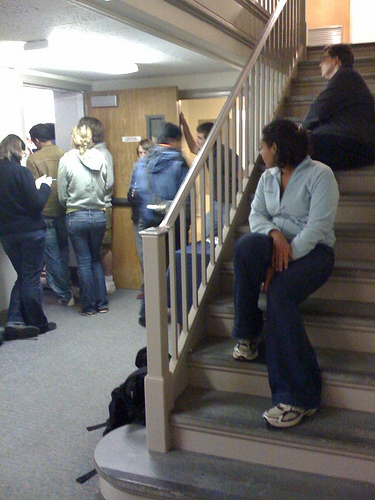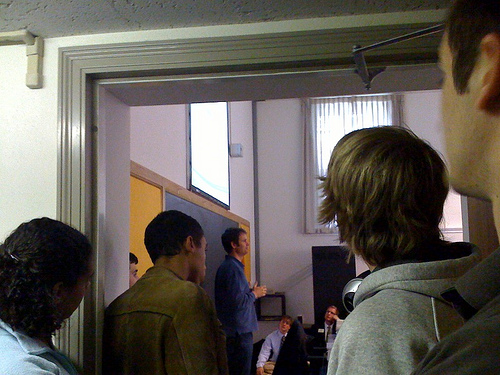This article is more than 5 years old.
It was standing room only! In case you missed it, or were unable to squeeze into the room or hallway outside 204, I’ve attempted to sum up the wowing presentation of Tim Westergren, founder of Pandora. A last count of attendance totaled 86, but people continued to accumulate in the hallway and stairwell. (if you missed the presentation, here is a link to the video)

Basics of Pandora
Founded in 2000, Pandora is an Internet radio service that stemmed from the Music Genome Project where music could be not only cataloged but navigated and synced. Additionally, playlists are customizable based on user preferences and 400 musical attributes, not simply mainstream popularity. Westergren found that the average time people spend a week listening to music is roughly 20 hours; 17 hours is spent listening to music through the radio and 3 hours listening to purchased music (CDs, MP3s, etc). Radio has always been the principal means of listening to music through mass broadcasting and pre-selected playlists, yet the amount of variety in music played on the radio is only a fraction of the music available. Therefore, Westergren sees the future of music in unicasting–listening to music over the web. Pandora allows users to not only customize their radio stations rather than listening to preset schedules but it also “solves the problem of finding and reconnecting to music” by syncing user preferences with other artists through unique musical attributes or granule details.
Tim Westergren, a Standford University Alumni and former musician and film composer, was so dedicated to the Music Genome Project, usability possibilities, and impact on the future of music, that he and other Pandora employees worked the first 3 years without salaries. He attributes the loyalty of employees during the early years to 1) sense of doing something great 2) an obligation to each other to stay dedicated 3) good leadership and inspiration and 4) a gambling-like addition to the project. Westergren and team began cataloging music by collecting any song or artist ever listed in the Billboard charts since 1957. After realizing the limited pool of variety and artists atop these charts, they expanded their search to include any artist or song recommended by a user or music submitted by the artists themselves. 30% of their artists pool has been added based on user recommendations.

He’s not only the founder of Pandora, but a client. You can check out his Pandora Profile here.
Business Model and Legalities of Pandora
Pandora is a free internet radio service–you only need to create an account/profile in order to save your playlist preferences and have access to the customizable features and recommendations. Pandora relies on both visual and audio advertising. With users interacting with the website on an average of 7 times an hour, visual advertising is the main source of advertising revenue. Audio advertisements on Pandora are still better than regular radio play in that Padora ads run 10-15 seconds and only 2 to 4 times an hour. With these regulations in place, Pandora is a brilliant alternative to illegally sharing music files, risking copyright infringement, and possibilities of copyright damages and lawsuits.
You may wonder how Pandora can do what they do without legal implications and copyright infringement. Well, Pandora can only legally operate within the United States of America under a federal statute of the Digital Millennium Copyright Act. This act prohibits Pandora from offering song-on-demand service, imposes a skip-song limitation, institutes a maximum play of 4 songs per artist per hour, and requires Pandora to pay a fraction of a penny per song in royalty fees per song per play. Two years ago, the US Copyright Royalty Board was set to raise the royalty fees to three times what Pandora was paying per song. According to Westergren, this move would bankrupt the company and force it to shut down. After many hours spent in litigation and failed appeals, Westergren organized a grassroots effort to save the online radio service. Having never advertised the website, Westergren petitioned its registered users to contact their congressional delegates and change the proposed rate increase. Over the course of 3 days Congress received more than 400,000 emails. By the end of the renegotiation petition, congressional delegates received 2+ million emails, phone calls, and letters arguing in support of Pandora. This grassroots effort not only saved the website from folding, but illustrated the power of their users and forced a renegotiation of costs.
Employees
Based in Oakland, California, Pandora employs 130 people, 35 of which are trained musicians given the task of assigning musical attributes to each song in the database. These attributes range from gender of the lead vocals and primary melodies to lyrical styles, type of background vocals, and level of distortion of lead guitar…a total of 400 attributes assigned. The 35 musicians spend roughly 20-30 minutes per song identifying these attributes and are so well trained that if you were to print out the attributes assigned to one song and lay them on a table, the musician could simply look at these granule details and hear the song in their head. Pandora employees catalog 150,000 songs a year, 30% of which is recommended through user preferences or submitted materials by the artists. For those music lovers out there that are interested in employment with Pandora, consider these stringent hiring requirements: you must be a professionally-trained musician (possessing a degree in Musicology), pass a song-analysis examination, and withstand over 100 hours of training. However, the rewards are working a 20-25 hour week with full benefits, having the flexibility to choose your workdays, and being a part of a fast-moving internet sensation!
Future Projects
Applications already exist to stream Pandora through smartphones such as the iPhone and Blackberry. However, future streaming projects include an application for the Palm Pre to increase the portability and mobility of streaming music. Additionally, Pandora is working to expand their Music Genome Project to include Celtic, Indian, and Canjun music. Currently Pandora has cataloged English, Portuguese, and Spanish music only.
Pandora statistics:
- 640,000 songs
- 90% of songs are played daily
- 70,000 artists
- 70% of artists are independent artists
- 25 million registered users
- 60,000 registered users added daily
- 4,000,000 users accessing Pandora through iPhones and Blackberries
- 20,000 new users accessing Pandora through smartphones daily
- 25% of users listening to Pandora while in the car
- 50% of users listening to Pandora through WiFi connection
- 150,000 songs cataloged a year
- 20 million dollar revenue in 2008
- 19 million of which was from visual and audio advertising
- 1 billion hours (yes, billion with a “B”) of music streamed in 2008
- currently projecting 3x that in 2009

6 Comments on ‘Tim Westergren speaks at ZSR’
Wow, what a fabulous summary! Are you sure this didn’t come from Wikipedia??? Sounds like a great program!
Heather, Congratulations on capturing ALL of the numerous interesting details that Tim shared about Pandora in the two sessions at ZSR today. I was most impressed with the 400+ attributes that are assigned for each song, manually by trained experts.
Amazing notes, Heather! Thanks for capturing!
I want to thank Heather, Mary Reeves and Mary Scanlon for all their work in pulling of this event!
Heather, you must have been so busy taking notes it’s hard to believe you enjoyed it! I however, enjoyed it all again, by reading your notes. It was a fabulous program and you captured it all. Thanks!
Heather, I wasn’t able to be there but with this summary I feel like I was. Thanks for the great reporting.